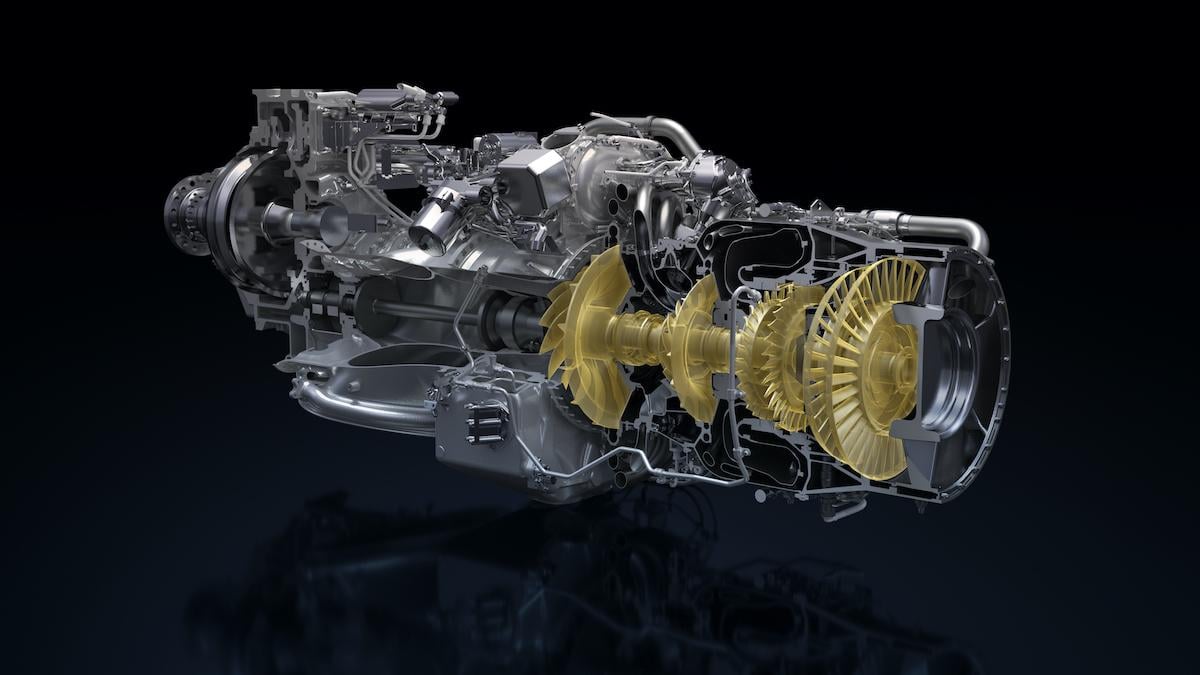
Regional turboprop developer ATR and Pratt & Whitney Canada (P&WC) have announced a long-awaited upgrade plan for the ATR 42/72 based on an extensively improved derivative of the PW127 engine family dubbed the XT.
“At ATR we are committed to zero emissions by 2050. That's a goal and a major milestone the entire industry set for itself,” ATR CEO Stefano Bortoli said at Dubai Airshow on Nov. 15. “But it has to be affordable, and what we are bringing to you today is an innovation that is new technology, its affordable and it's listening to customers.”
“The XT will be the new standard and will be retrofittable to the [ATR] 500 and 600. It has already been flying in France since June and has been proven. It will be part of the standard configuration of our aircraft from the second half of 2022,” Bortoli said.
Building on the existing PW127M series and incorporating some of the technologies and enhancements developed for the engine maker’s Next Generation Regional Turboprop (NGRT) program, the PW127XT will provide a 3% improvement in fuel efficiency over the current powerplant. The new engine will also have a 40% extended time on wing and 20% lower maintenance costs.
As with other P&WC engines, the PW127XT-M engines are certified for up to a 50% sustainable aviation fuel (SAF) blend. The engine-maker says it is on track to certify the new derivative in the second quarter of 2022. “The XT is the first model in this series and we are going to set a new standard for operating economics as well as sustainability,” said Maria Della Posta, president of P&WC.
Major changes include a new, high-flow low pressure compressor and a higher efficiency high pressure compressor; a new, more robust high pressure turbine module; and an improved power turbine module. The XT also incorporates a revised gas generator case with an improved oil distribution system. The engine will be rated at 2,750 shp mechanically, and 3,360 shp thermodynamically—providing more operating margin than the current engine’s 3,200 shp rating.
The XT marks the first significant upgrade for the ATR family powerplant since P&WC received type certification from Transport Canada and EASA for the PW127M in 2008. At the time the PW127M offered 5% more power than its long-running predecessor, the PW127F.
P&WC’s move with ATR to offer a near-term performance, operability and sustainability upgrade for the PW127-powered ATR 42/72 also comes as both companies explore longer term non-conventional propulsion options. The engine-maker is also working with De Havilland Canada to develop a hybrid-electric propulsion demonstrator based on the Dash 8-100. The C$163 million project targets the start of flight tests in 2024 and is a successor to Project 804, an earlier hybrid demonstrator plan which was subsequently sidelined. Ground testing is targeted for 2022.
Under the project, which targets a 30% reduction in fuel burn and CO2 emissions on a 250-mi. sector compared to a current state-of-the-art regional, one of the aircraft’s standard PW121 turboprops will be replaced with a megawatt-scale hybrid-electric power train. The Collins-developed electric motor and controller will be powered by a turbogenerator and a battery system.
As with Project 804, for which P&WC planned to use a novel thermal engine, the manufacturer is not revealing details of the Dash 8 demonstrator powerplant other than saying it is optimized for hybrid-electric operation “with the electric motor boosting power during takeoff and climb.”
ATR meanwhile is seeing an increasing number of its operators also planning to switch to hydrogen-fuel cell-based propulsion. U.S. startup Universal Hydrogen (UH2) has signed letters of intent with Icelandair Group, Air Nostrum and Ravn Alaska to retrofit ATR 72 and Dash 8s with hydrogen fuel-cell propulsion systems which will see the aircraft’s P&W PW124/127 turboprops replaced with electric motors and fuel cells compatible with UH2’s modular hydrogen system. Developed with electric motor developer MagniX, UH2 plans to begin experimental flights in 2023, aiming for supplemental type certification and entry into service by 2025.
Another startup, ZeroAvia, has also signed an agreement with Irish cargo airline ASL Aviation Holdings to convert an ATR 72 freighter to hydrogen fuel-cell propulsion. ASL signed a similar letter of intent with startup Universal Hydrogen (UH2) in October. Under the agreement, ASL will provide a retired ATR 72 freighter for retrofit with ZeroAvia’s larger, 2-5-megawatt ZA2000 hydrogen-electric powertrain and use as a development aircraft and demonstrator. The project could lead to an order to convert up to 10 of ASL’s ATR 72s for service from 2026.
